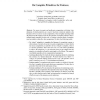95
Voted
TCC
2010
Springer
15 years 7 months ago
2010
Springer
A number of works have investigated using tamper-proof hardware tokens as tools to achieve a variety of cryptographic tasks. In particular, Goldreich and Ostrovsky considered the ...
73
Voted
TCC
2010
Springer
15 years 7 months ago
2010
Springer
TCC
2010
Springer
15 years 9 months ago
2010
Springer
Abstract. We propose a semantically-secure public-key encryption scheme whose security is polynomialtime equivalent to the hardness of solving random instances of the subset sum pr...
120
Voted
TCC
2010
Springer
15 years 9 months ago
2010
Springer
We construct a fully secure HIBE scheme with short ciphertexts. The previous construction of Boneh, Boyen, and Goh was only proven to be secure in the selective model, under a non...
106
Voted
TCC
2010
Springer
15 years 9 months ago
2010
Springer
We present a variant of Regev’s cryptosystem first presented in [Reg05], but with a new choice of parameters. By a recent classical reduction by Peikert we prove the scheme sema...
70
Voted
TCC
2010
Springer
15 years 9 months ago
2010
Springer
TCC
2010
Springer
15 years 9 months ago
2010
Springer
The strongest standard security notion for digital signature schemes is unforgeability under chosen message attacks. In practice, however, this notion can be insufficient due to �...
TCC
2010
Springer
15 years 9 months ago
2010
Springer
We describe the first domain extender for ideal ciphers, i.e. we show a construction that is indifferentiable from a 2n-bit ideal cipher, given a n-bit ideal cipher. Our construc...
TCC
2010
Springer
15 years 9 months ago
2010
Springer
We study rationality in protocol design for the full-information model, a model characterized by computationally unbounded adversaries, no private communication, and no simultanei...
100
Voted
TCC
2010
Springer
15 years 9 months ago
2010
Springer
Abstract. For secure two-party and multi-party computation with abort, classification of which primitives are complete has been extensively studied in the literature. However, for...





